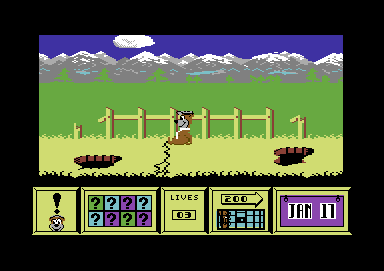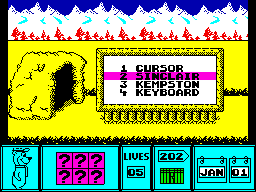Retro Replay Review
Gameplay
The core of Yogi Bear revolves around navigating a multi-layered, side-scrolling version of Jellystone Park, with each of the 198 screens presenting its own set of challenges. As Yogi, you must move seamlessly in and out of foreground and background layers, timing jumps and dashes to avoid hazards like snapping animals, black holes, and water pits. The game’s control scheme is straightforward—directional movement plus a jump button—but mastering the precise timing for inter-layer transitions can be surprisingly engaging.
(HEY YOU!! We hope you enjoy! We try not to run ads. So basically, this is a very expensive hobby running this site. Please consider joining us for updates, forums, and more. Network w/ us to make some cash or friends while retro gaming, and you can win some free retro games for posting. Okay, carry on 👍)
Energy management adds another layer to the gameplay experience. Yogi’s stamina depletes with every step and hostile encounter, so players must keep an eye out for replenishment items. Fish and pick-a-nick baskets refill energy, but they’re often placed in hard-to-reach spots or guarded by roaming tourists and the park ranger. Balancing risk and reward becomes essential, especially when you’ve only a sliver of health left and the next replenishment item is just out of reach.
Collecting the six toffee apples is the primary side objective that ties directly into the rescue of Boo-Boo. These apples act as key fragments that convert into a rescue code, preventing Boo-Boo’s kidnapper from causing a fuss. This mechanic encourages thorough exploration of each screen rather than a simple rush to the exit. Combined with the looming deadline of winter hibernation, the toffee apple quest injects a welcome sense of urgency and replay value into each playthrough.
Graphics
Yogi Bear’s visual presentation embraces the classic 2D pixel art style of its era, delivering a bright, cartoon-inspired palette that feels true to its source material. The backgrounds showcase layered forest vistas and picnic clearings, with parallax scrolling offering depth as Yogi moves between planes. Although the hardware limitations impose a somewhat blocky look, character sprites—including Yogi, Boo-Boo, tourists, and various wildlife—are distinct and expressively animated.
The layered-screen mechanic is reinforced by subtle visual cues: dimmer shading on background layers and slightly larger sprites in the foreground. These touches help players intuitively discern which plane they’re on, reducing trial-and-error frustration. Water hazards ripple with basic animation, and black hole entrances swirl with a dark vortex effect, both serving as not only obstacles but memorable visual landmarks within the park’s sprawling landscape.
While the majority of sprites are well-designed, occasional repetition in tree tiles and bush patterns can make certain sections feel a bit monotonous. However, the color contrast between safe zones (like grassy knolls) and danger zones (cliff edges, riverbanks) remains sharp and clear, ensuring that players can quickly assess threats. The overall aesthetic celebrates the whimsy of the animated franchise, which will likely resonate with fans of classic cartoons and retro platformers alike.
Story
The narrative premise of Yogi Bear is charmingly simple: Boo-Boo has been kidnapped, and it’s up to Yogi to brave Jellystone Park’s perils and bring him home. This straightforward rescue mission is sprinkled with lighthearted quips and visual nods to the cartoon series, creating a warm, family-friendly atmosphere. The looming hibernation deadline adds a subtle tension—fail to rescue Boo-Boo in time, and both bears will miss winter slumber, a fitting cartoonish consequence.
Story progression is conveyed mostly through level design rather than cutscenes, which keeps gameplay fluid but leaves some narrative beats to the player’s imagination. You glean snippets of the plot when collecting each toffee apple, as if you’re piecing together Boo-Boo’s secret code step by step. Although there’s no voice acting or in-depth dialogue, the light storytelling approach ensures that the focus remains on platforming fun rather than heavy plot exposition.
Despite its brevity, the storyline provides enough motivation to keep players invested across nearly 200 screens. The simple “rescue your friend” premise is timeless and effective, particularly for younger gamers or those seeking a nostalgic romp through video game parkland. For players who prefer narrative-heavy experiences, the minimal story beats may feel sparse, but for platforming purists, the plot serves its purpose as a charming backdrop.
Overall Experience
Yogi Bear delivers a deceptively deep platforming challenge beneath its cheerful, cartoonish exterior. The combination of layered screens, energy management, and item-collection objectives creates a gameplay loop that feels both accessible and rewarding. While the difficulty curve ramps up considerably in later screens, the sense of accomplishment when you finally decode the toffee apples and rescue Boo-Boo is genuine and satisfying.
Graphically, the game may not push modern hardware, but it captures the spirit of its animated roots with bright colors, lively sprites, and a playful approach to environmental hazards. The lack of repetitive cutscenes helps maintain pacing, and the decision to convey most of the story through gameplay keeps players engaged in the action. Sound design leans into cheerful beeps and jingles, complementing the light-hearted aesthetic without becoming grating.
For fans of classic platformers and casual gamers seeking a friendly, nostalgia-infused adventure, Yogi Bear offers a delightful romp through Jellystone Park. The combination of exploration, strategy, and arcade-style action makes it suitable for both solo sessions and group play in retro gaming collections. While not without occasional repetitive backdrops and tight difficulty spikes, the overall experience remains charming, engaging, and well worth a place in any enthusiast’s library.
 Retro Replay Retro Replay gaming reviews, news, emulation, geek stuff and more!
Retro Replay Retro Replay gaming reviews, news, emulation, geek stuff and more!









Reviews
There are no reviews yet.